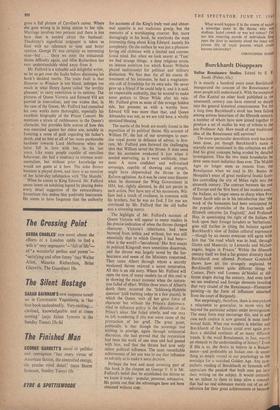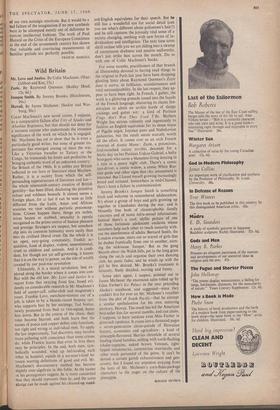Burckhardt Disappears
Italian Renaissance Studies. Edited by E. F. Jacob. (Faber, 63s.) IT is exactly a hundred years since Burckhardt inaugurated the concept of the Renaissance as most people still understand it. With the exception of Das Kapital no other book published in the nineteenth century can have entered so deeply into the general historical consciousness. Yet fot a long time Burckhardt's stock has been falling among serious historians of the fifteenth century, a number of whom have now joined together to produce a set of studies by way of tribute to the late Professor Ady. How much of our traditional idea of the Renaissance still survives?
The more spectacular demolition work has long been done, yet though Burckhardt's name is scarcely ever mentioned in this collection we still find his great concepts being eroded by detailed investigation. Thus the two main boundaries he drew seem more indistinct than ever. The Middle Ages no longer seem so remote from the Renaissance when we read in Mr. Bueno de Mesquita's essay of great medieval feudal fami- lies controlling the city of Milan right into the sixteenth century. The contrast between the rest of Europe and the 'first born, of her modern sons,' the Italians, no longer seems so sharp when Pro- fessor Jacob tells us in his introduction that 'the work of the humanists had been anticipated by the popular chronicles of the fourteenth and fifteenth centuries [in England].' And Professor Hay, in questioning the right of the Italians to look upon their foreign invaders as 'barbarians,' goes still further in tilting the balance against Burckhardt's view of Italian cultural supremacy —though by no means everyone will agree with him that 'the road which was to lead, through Giotto and Masaccio, to Leonardo and Michel- angelo, begins in France.' Within the fifteenth century itself we find a far greater diversity than Burckhardt ever allowed. Professor Gombrich shows how art (so strangely neglected by Burckhardt) meant quite different things to Cosimo, Piero and Lorenzo de'Medici at dif ferent stages during the century. And even here we see medieval and foreign elements invading that very citadel of the Renaissance—Florentine painting—in the form of influences absorbed from the court of Burgundy.
Not surprisingly, therefore, there is everywhere a reluctance to generalise, to move very fat beyond the particular subject under investigation.
The essay form may encourage this, and in any case such caution is now general in most intel- lectual fields. What one wonders is whether any Burckhardt of the future could ever again pro•
duce a distilled synthesis of so many different trends. Is the word Renaissance, in fact, merely
an obstacle to the understanding of history? Even
if this is so, the desire to believe in a Renais- sance—and preferably an Italian one—is some- thing as deeply rooted in our psychology as the
nostalgia for a vanished Golden Age. Any sym- pathetic reading of Burckhardt or Symonds will appreciate the passion that both men put into
their writing on the subject. It would certainly be no tribute to them to keep alive a concept that had no real substance merely out of an ad- miration for their great achievements or because
of our own nostalgic emotions. But it would be a sad failure of the imagination if no new synthesis were to be attempted merely out of deference to current intellectual fashions. The work of Paul Hazard on the Crisis of the European Conscience at the end of the seventeenth century has shown that valuable and convincing reassessments of familiar periods arc perfectly possible.
FRANCIS HASKELL











































 Previous page
Previous page